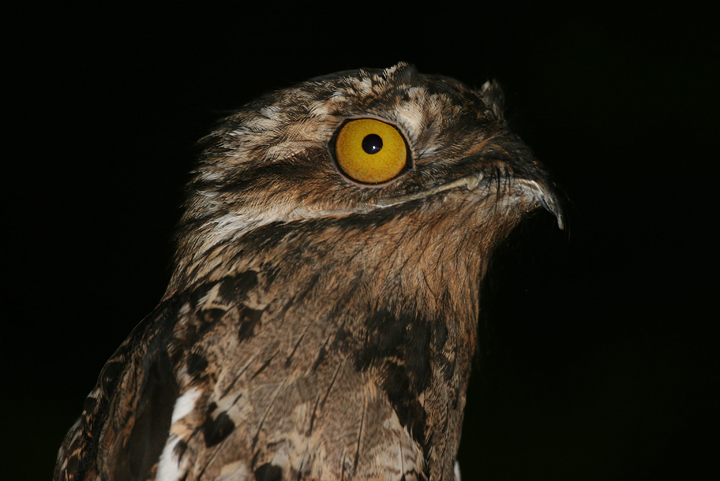The Common, or Greater Potoo is part of the frogmouth, nightjar and nighthawk family. These birds are well adapted for flying and, in fact, cannot walk or hop. They spend their days roosting, mimicking tree branches and their nights darting after prey. These birds are nocturnal and feed mostly on flying insects.
Their bodies are quite round, and their heads and eyes are very large. The most unique and distinguishing factor however, is their extremely wide, gaping mouths. These mouths must be wide to capture insects as they dive out of trees. The potoo's tail and wings are also adapted for their lifestyle, they're long and wide, enabling them to maneuver after their prey.
These animals can reach a length of 13-15 inches and weigh around 5-7 ounces. They are cryptically colored and between their camouflage and stock-still pose, they are hard to distinguish from the tree branches they use as perches.
The Common Potoo is found in Central and South America. It can be located in trees at night only by it's shining eyes, which it keeps closed during the day so predators are not attracted to them. The potoo has a distinct call which can be described as a Bo-ou, bo-ou, bo-ou.
Their bodies are quite round, and their heads and eyes are very large. The most unique and distinguishing factor however, is their extremely wide, gaping mouths. These mouths must be wide to capture insects as they dive out of trees. The potoo's tail and wings are also adapted for their lifestyle, they're long and wide, enabling them to maneuver after their prey.
These animals can reach a length of 13-15 inches and weigh around 5-7 ounces. They are cryptically colored and between their camouflage and stock-still pose, they are hard to distinguish from the tree branches they use as perches.
The Common Potoo is found in Central and South America. It can be located in trees at night only by it's shining eyes, which it keeps closed during the day so predators are not attracted to them. The potoo has a distinct call which can be described as a Bo-ou, bo-ou, bo-ou.
Potoos are monogamous in their breeding habits. They are usually solitary, but will pair for mating and will both incubate the egg. One egg is laid, commonly on a stump or branch depression. The egg will be purplish with brown spots or white with lilac spots. The egg hatches after about a month after incubating and will nest for about two months.
Images from:
http://luis.impa.br/foto/1009_aves_pantanal/mae-da-lua-gigante_PANTANAL-100924-O_56398-rawaa.jpg
Video from:
http://www.youtube.com/watch?v=L9nmGyrMPiY
Video from:
http://www.youtube.com/watch?v=L9nmGyrMPiY



No comments:
Post a Comment